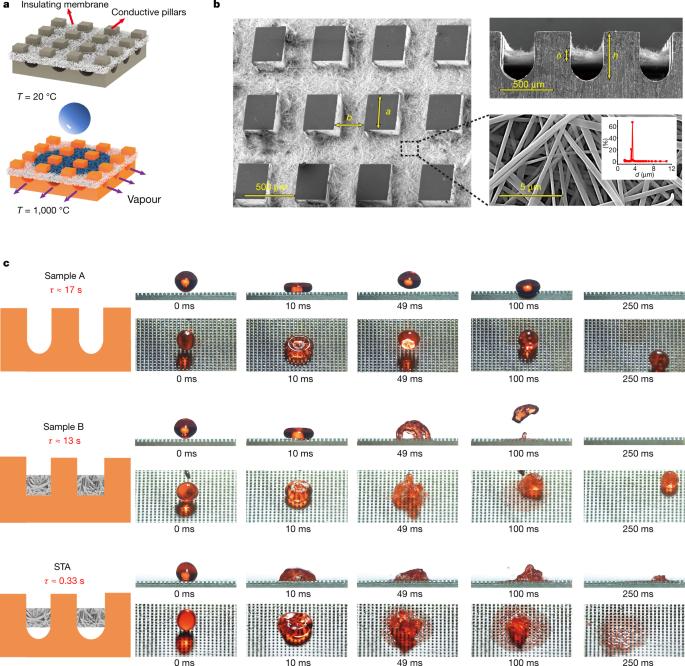Inhibiting the Leidenfrost effect above 1,000 °C for sustained thermal cooling
IF 50.5
1区 综合性期刊
Q1 MULTIDISCIPLINARY SCIENCES
引用次数: 85
Abstract
The Leidenfrost effect, namely the levitation of drops on hot solids1, is known to deteriorate heat transfer at high temperature2. The Leidenfrost point can be elevated by texturing materials to favour the solid–liquid contact2–10 and by arranging channels at the surface to decouple the wetting phenomena from the vapour dynamics3. However, maximizing both the Leidenfrost point and thermal cooling across a wide range of temperatures can be mutually exclusive3,7,8. Here we report a rational design of structured thermal armours that inhibit the Leidenfrost effect up to 1,150 °C, that is, 600 °C more than previously attained, yet preserving heat transfer. Our design consists of steel pillars serving as thermal bridges, an embedded insulating membrane that wicks and spreads the liquid and U-shaped channels for vapour evacuation. The coexistence of materials with contrasting thermal and geometrical properties cooperatively transforms normally uniform temperatures into non-uniform ones, generates lateral wicking at all temperatures and enhances thermal cooling. Structured thermal armours are limited only by their melting point, rather than by a failure in the design. The material can be made flexible, and thus attached to substrates otherwise challenging to structure. Our strategy holds the potential to enable the implementation of efficient water cooling at ultra-high solid temperatures, which is, to date, an uncharted property. Structured thermal armours on the surface of a solid inhibit the Leidenfrost effect, even when heated to temperatures in excess of 1,000 °C, pointing the way towards new cooling strategies for high-temperature solids.

抑制 1,000 °C 以上的莱顿弗罗斯特效应,实现持续热冷却
众所周知,莱顿弗罗斯特效应(即液滴在高温固体上的悬浮效应1 )会在高温条件下恶化传热效果2。通过对材料进行纹理处理,使其有利于固液接触,2-10 以及在表面设置通道,使润湿现象与蒸汽动力学分离,可以提高莱顿弗罗斯特点3。然而,在广泛的温度范围内最大限度地提高莱顿冰点和热降温是相互排斥的3,7,8。在此,我们报告了一种合理的结构化热铠装设计,它能在高达 1,150 °C 的温度下抑制莱顿-弗罗斯特效应,比以前的设计高出 600 °C,但仍能保持热传递。我们的设计由作为热桥的钢柱、用于吸湿和扩散液体的嵌入式隔热膜以及用于蒸汽排空的 U 型通道组成。具有截然不同的热性能和几何特性的材料共存,可将通常均匀的温度转化为不均匀的温度,在所有温度下都能产生横向排汗,并增强散热效果。结构化热护甲仅受其熔点的限制,而不是设计上的失败。这种材料具有柔韧性,因此可以附着在基底上,否则结构设计将面临挑战。我们的策略有可能在超高固体温度下实现高效水冷却,而这是迄今为止未知的特性。固体表面的结构化热铠甲可抑制莱顿弗罗斯特效应,即使加热到超过1000 °C的温度也是如此,这为高温固体的新型冷却策略指明了方向。
本文章由计算机程序翻译,如有差异,请以英文原文为准。
求助全文
约1分钟内获得全文
求助全文
来源期刊

Nature
综合性期刊-综合性期刊
CiteScore
90.00
自引率
1.20%
发文量
3652
审稿时长
3 months
期刊介绍:
Nature is a prestigious international journal that publishes peer-reviewed research in various scientific and technological fields. The selection of articles is based on criteria such as originality, importance, interdisciplinary relevance, timeliness, accessibility, elegance, and surprising conclusions. In addition to showcasing significant scientific advances, Nature delivers rapid, authoritative, insightful news, and interpretation of current and upcoming trends impacting science, scientists, and the broader public. The journal serves a dual purpose: firstly, to promptly share noteworthy scientific advances and foster discussions among scientists, and secondly, to ensure the swift dissemination of scientific results globally, emphasizing their significance for knowledge, culture, and daily life.
 求助内容:
求助内容: 应助结果提醒方式:
应助结果提醒方式:


